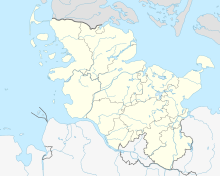Wesseker See
Coordinates: 54 ° 18 ′ 12 ″ N , 10 ° 48 ′ 26 ″ E
The Wesseker See is a lake and nature reserve in the Schleswig-Holstein community of Wangels and the city of Oldenburg in Holstein in the Ostholstein district .
Nature reserve
The 245.89 hectare nature reserve is registered with number 58 in the register of nature reserves of the Ministry of Agriculture, Environment and Rural Areas. It was expelled in 1961 (date of regulation: February 3, 1961). The nature reserve is part of the FFH area "Strandseen der Hohwachter Bucht" and the EU bird sanctuary "Eastern Bay of Kiel". The responsible lower nature conservation authority is the Ostholstein district. The nature reserve is looked after by the Schleswig-Holstein regional association of the German Nature Conservation Union .
The nature reserve is located northwest of Oldenburg in Holstein in the Oldenburger Graben . It puts the Wesseker See and the adjacent areas under protection. The lake is by extensive reed areas and sedges - and rushes surrounding marshes.
The lake, originally around 150 hectares in size, has shrunk to around 50 hectares due to drainage measures. The water depth of the lake, which is 30 cm deep on average, is often only 15 cm. There is a thick layer of mud underneath. The shore length of the lake is around 3.1 km. When the Baltic Sea floods, excess water from the Oldenburger Graben, which can no longer be pumped into the Baltic Sea via pumping stations, is channeled into the Wesseker See.
The reed areas around the Wesseker See are the habitat of the bittern . Since the reeds were partly used for commercial reed mowing and the animals lacked cover, parts of the nature reserve were no longer used as a breeding area for the bittern. In the meantime, private areas have been bought up and taken out of use.
The lake is considered a body of water of national importance for water birds . It is also of international importance as a sleeping place for spoonbills and gadgets . The sea eagle is also native here.
Web links
- Natura 2000 in the nature reserve "Wesseker See" and in the western Oldenburger Graben , leaflet of the State Office for Agriculture, Environment and Rural Areas of Schleswig-Holstein (PDF, 981 kB)
Individual evidence
- ^ Ordinance on the "Wesseker See" nature reserve of February 3, 1961 , state regulations and state case law, state government Schleswig-Holstein. Retrieved March 21, 2013.
- ↑ Beach lakes in Hohwacht Bay , profiles of the Natura 2000 areas, Federal Agency for Nature Conservation . Retrieved March 12, 2020.
- ^ Eastern Bay of Kiel , profiles of the Natura 2000 areas, Federal Agency for Nature Conservation. Retrieved March 12, 2020.
- ^ Supervision of protected areas in Schleswig-Holstein , State Office for Agriculture, Environment and Rural Areas , April 2017 (PDF, 275 kB). Retrieved March 12, 2020.
- ↑ a b Oldenburger Graben , landscape profile, Federal Agency for Nature Conservation. Retrieved May 24, 2019.
- ↑ Wesseker See has a good chance of being renatured , Ostholstein district, October 28, 2009. Accessed on March 21, 2013.
- ↑ Wesseker See , Characteristic Data, Agriculture and Environment Portal, Ministry for Energy Transition, Agriculture, Environment and Rural Areas Schleswig-Holstein. Retrieved March 21, 2013.
- ^ Oldenburger Grabenniederung , Interest Group Oldenburger Graben e. V (PDF, 317 kB). Retrieved March 21, 2013.
- ↑ Knut Jeromin, Bernd Koop: Study of the widespread bird species in Appendix I of the EU Birds Directive in Schleswig-Holstein 2008 , Ornithological Working Group for Schleswig-Holstein and Hamburg, November 2008 (PDF file, 262 kB). Retrieved March 21, 2013.
- ↑ Weißenhäuser Broek and Wesseker See ( Memento from March 4, 2016 in the Internet Archive ), LIFE -BaltCoast, Foundation for Nature Conservation Schleswig-Holstein .
- ↑ Sea eagle protection: 6000 euros should help , Ostholsteiner Anzeiger , November 16, 2012. Retrieved on March 16, 2016.


